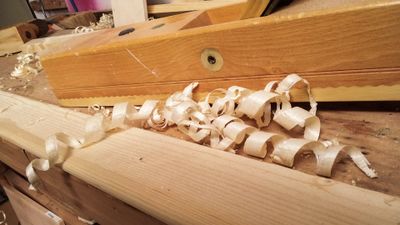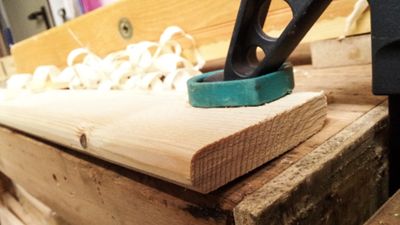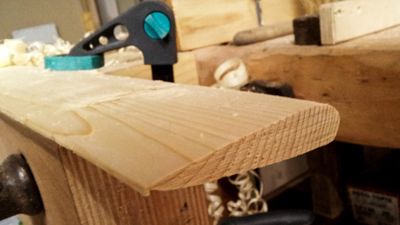Tiny Vertical Axis Wind Turbine (TiVA)
Introduction
The Tiny Vertical Axis Wind Turbine is a wind energy harvesting and testing platform for anybody. All information is released open source and for free, for a better world and for the fun of open collaboration. (CC BY-SA)
Part of the modular Wind Turbine system is a downscaled VAWT called TiVA with tiny dimensions. With these inexpensive, small prototypes we can have a fast prototyping and research pace. Any successful design approaches may then be scaled up and used at larger turbines. TiVA is also a prototyping platform for educational purposes: Students, teachers, hackers and anybody with interest in the topic can learn and tinker with renewable energy harvesting in a small scale.
Status
The TiVA is currently in the research phase of product development, we are focusing on the dimensions and design of it's single components right now with 3D modeling and simulation parallel with the real life prototyping: We encourage the use of CAE, are working with 2D/3D CAD, and made first steps in simulating with CFD + FEA. We try to minimize it with designing and calculating as much as possible, but real life testing is of course very important, too. A wooden rotor base with bearings has already been machined, NACA0018 wings have been prototyped and tested. First results are, that lift profiles like the NACA0018 airfoil are very inefficient at small turbine dimensions and low wind speeds, but efficient at large dimensions and medium to high wind speeds. This is because the critical Reynolds number can be accomplished at a large diameter, but not at a small turbine.
Prototyping
We are gathering the resources for the first prototypes, here is a rough bill of materials for a first prototype: Media:Tiva_bom_prototype_p1.pdf.
TODO: post a list with all the parts needed for one TiVA.
Still searching for this project: Someone with the ability to establish FEM simulations of different rotor type models and mechanics to analyze stress points in the mechanics and to optimize the rotors performance.
YOU
Is there anything you can supply or contribute? Please get in touch with Alex or make a post in our Forum. :-)
Funding with parts or money is very welcome!
TiVA design outlines
<50cm long parts can be cut out at almost every small CNC milling machine.
48cm wings can be made out of:
- styrofoam, Styrodur etc with a hot wire CNC cutter
- the famous 2-by-4s with a planer
- like an R/C plane wing with wooden rips and a foiled surface
- sheet metal, aluminium sheeting bent over cores [rips]
- wooden sheet material
- plastic pipes
fixed main shaft: Do = 8 mm, 608ZZ radial single race bearings rotating turbine assembly, rotor shaft where the bearings seat: Di = 22 mm
At this size, a single I-beam design should be suitable, not a dual-bridge-H-rotor assembly.
A V rotor looks promising, too. Resource demand is further reduced with this type of rotor. two bladed or three bladed? apparently, two bladed designs have severe problems with low wind conditions and self-starting issues => three bladed.
V-rotor advantages:
- least amount of material for a given lift-type wing surface
- best wing volume vs static structural volume ratio
- only one wing-fixture-point
- no bridges, less moving parts
- less connections, less machining operations, less screws or welds
- dissassembly is easier
- uses a higher surface at a larger height, less turbulences at the ground
- (tbd) less prone to oscillations?
- snow can't set onto most of the rotor
- can be adapted to also use up-winds in urban environments, especially interesting at the top of buildings.
__ __ <-test if winglets make a difference
\ / <- place a rope here, or lower;
\----/ <- to cope with centripetal forces at high rpm
\ / <- wings in V-form
\/ <- plate with wing-fixtures and seats for the two bearings
|| <- shaft/rotor coupling with two bearings
_/\_ <- any type of stand or clamp, generator, electronics
>I was thinking that we can't have a reliable absolute measuring device, so if all devices are built the same way then we can have a relative measuring device... >>That is right, because there is no wing-tip-speed ratio at drag rotors. Perfect no-load drag wings have a wing-tip-speed ratio of one, thus rotating as fast as the wind ;) >we would have to have half-cups as wings to form an actual absolute wind speed measure device like those things you can buy and don't put any load at the generator.
- Build a lovely grid and show, that wind turbines can be fun - we visualize the unused wind speed and energy. Plus it would be easy to deploy and portable, system voltage of 5V would provide charging power for mobile phones etc. USB power output could be easily done, fed by a 5 V buck-boost converter and 4 AA cells.
- can serve as a measure+log device for wind speeds
- has on-board electronics: switching power supply, 3.3V or 5V system voltage for MCU and electronics+LEDs, goldcap ?, mcu recommendation: either a low power ti MSP 16bit on a launchpad or the ordinary Atmel Atmega 328(pu) with an Arduino bootloader (or derivative) -> both would be diy-friendly and cheap.
- logging shield with shunts and opamps, goldcap, hprgb shield with logic level mosfets, software pwm.
- Reliable measurement is difficult in many ways, because devices would have to be calibrated in a (diy) wind tunnel. But let's see how far we get.
- can be deployed on a field, in an urban environment etc, flexible and mobile.
- one high power RGB LED acts as a universal signal: can be an indicator for wind speed, keep-alive.. or a 3 x 8 bit digital pixel.
If deployed in an array on a field or in an urban environment: in low natural light conditions, at sundawn or in the night, the wind pattern can be determined by the flash+color pattern of the small wind turbines. MCU logging onto e.g. micro-sd card or via wireless link is an optional step.
It would be a very cool art piece at night if all turbines would be connected to a master (which would be easy outdoors on a field) or connected in a grid. A pattern could be generated and all turbines could flash in sync. single flashes could be emitted with full power even if the wind conditions are bad, just the off-periods may be pretty long then.
- nodes may be connected (for example a cheap NRF24L01 node-based-network) or even simpler:
- the hp-LED is used as a transmitter and a cheap photo transistor as a receiver. Think of an infra-red remote control but with visible light and with much more power.
- Use a present IrDA protocol, for example IrSimple. (check the web for existing implementations and libraries in C for the MSP or AVR platform.)
- A system similar to ROnja, but without any lenses. Maybe clock can help us out?
- TiVAs can be attached to the top of a tree, especially to free-standing ones. No pole required and higher wind speeds gained: win-win.
- For a rough estimation, if the VAWT is working and how the wind condition is: Stick a thick wool or thin polythene (bin liner) tell-tales onto the top of the blades. This gives an indication of the relative speed of the blades and it is quite simple to see if the turbine is just being blown around by the drag on the downwind rotor or 'actually' running.
- A tell-tale in the centre of the rotor between the blades; so one can see the airflow through the rotor. As the rotor starts this will still blow out sideways, but when the rotor is running (without any load), it will hang limp indicating very little air flowing through the turbine. A gust or putting load on the turbine/generator will cause it to blow out sideways due to the wind which gets through.
Mechanics
Forces
Density of air = about 1.2 Kg/m³
Coefficient of drag = 1.0 (cylinder Re > 100)
Area of turbine
Wind speed in m/s
Rotor and wings
Compared to drag-only type rotors (Savonius), the lift-only type rotors (Darrieus) haven proven to be generally less suitable for low wind environments and for small sized rotors. However, the maximum speed of drag-only type rotors is always lower than a comparable lift-only type rotor, because a lift-only type rotor can rotate faster than the wind speed at the tips but with less torque. A drag-only type rotor can develop more torque, even at early stages in low wind conditions. At a large turbine diameter with a direct driven alternator, this would require a very specific and resource-intensive generator to accommodate for the very low rotational speed. A typical low end for a direct driven axial flux permanent magnet alternator with many poles is about 150 revolutions per minute. Everything under 150 rpm means huge additional resource investments into rare earth magnets and loads of copper (windings).
For the very small TiVA, the research focus will be on three wing types, either of them mounted on a H (with arms) or V (with a base mount) or sandwich (base and top plate) shaped rotor:
- A lift-only type wing profile. The wings are formed by one (NACA) profiled element or segments of pipes, e.g. made of DN100-PE-tubes (standard sewer piping in Germany)
- The Van Canstein wing form and further derivatives based on it, with less parts if possible.
- The Lenz2 wing profile, a combined lift-and-drag profile developed by Edwin Lenz from windstuffnow.com.
The lift-only type wing profile has been successfully tested by now with the NACA0018 airfoil. Testing concluded that we will not further investigate lift profiles with TiVA, as the Reynolds number is much too low at these small dimensions, thus the rotor could not revolve faster than a TSR[1] of 2 with not load. A TSR of at least 3 would be required to be reasonably efficient. In addition to the low TSR, the NACA0018 profile had a low performance in low to medium wind speeds vs a crude drag profile and could not self-start at all.
C-Type Rotor
The "Van Canstein" wing form is a special type of H-rotor with a combined lift-and-drag-wing.
H-Type Rotor
- may be the simplest design, very simple wing forms are possible.
Complex Darrieus rotor: wings in helix-form, spiraled, lift-type Simpler H-rotor: wings straight. May even be without any profile. Lift-type or Drag-type or lift-drag-type -> C-rotor
C-type vs simple H-type
con C-type, pro H-type:
- C-type requires two parts to form a wing -> more material
- wing tip has to be bent into an aerodynamic shape -> more complexity, especially at the mounting points
- upper wind speed limit is lower
pro C-type, con H-type:
- C-type requires lower wind speed, creates higher torque at lower wind speeds
- usable bandwidth of wind speed is higher
NACA0018 profiled straight wing fabrication process
One idea is to make a wing out of two symmetrical pieces. One half of the profile could be milled out of wooden sheet material or planed out of a pre-cut board by hand. Half of a profile can be hold down and clamped because one side will still be flat. The two halves are then glued together.
The pictures at the right show a simple profile made out of thin boards. They are cut out of a sheet with a table saw and then planed by hand.
Power estimation and electronics
All calculations are made in the metric system. Corrections and additional approaches are always welcome.
Power in the wind:
is the power, which is available in the wind, as kinetic energy
Density of air = about 1.2 Kg/m³
Surface area of the wind facing functional turbine area
Wind speed in m/s
Estimated Wind-Power conversion (mechanical):
while
A tuned VAWT may have a best-case efficiency of 40%[2], while a simple drag-based turbine with no optimization nor special aerodynamics may have an efficiency of about 20%.
| m/s | km/h | ||||
| 1.8 | 6.5 | 0.35 | 0.5 | ||
| 4.5 | 16.00 | 5.5 | 8.2 | ||
| 6.25 | 22.50 | 15 | 22.6 | ||
| 8.0 | 29 | 32 | 48 |
| m/s | ||||
| 1.8 | 0.35 | 0.07 | 0.1 | |
| 4.5 | 5.5 | 1.1 | 1.65 | |
| 6.25 | 15 | 3 | 4.5 | |
| 8.0 | 32 | 6.4 | 9.6 |
| m/s | ||||
| 1.8 | 0.5 | 0.1 | 0.15 | |
| 4.5 | 8.2 | 1.65 | 2.5 | |
| 6.25 | 22.6 | 4.5 | 6.8 | |
| 8.0 | 48 | 9.6 | 14.4 |
- Assuming a bad (20%) or decent (30%) turbine design \rho_{turbine}=0.26
- A rather bad permanent magnet alternator with \rho_{alternator}=0.75;
- A normal synchronous rectifier with superb-by-design perfomance of \rho_{rect}=0.98;
- A buck-boost inverter with a good performance of \rho_{rect}=0.85;
Conclusion: A 0.32m x 0.32m drag-only VAWT generates about P_{mech} = 0.1...10 W and in average German wind conditions (3 - 4 m/s?) about 0.5 - 1 W. If we have a good alternator (which will be easier at this size because of the high rpm) and a synchronous rectifier (rectifier not necessary if buck/boost power supply doesn't need DC, are there suitable packages for this mode?), most of the power will be available as an input for a buck/boost converter, which can operate reasonably well at these small power ratings.
Assuming a worst-case average electrical power of 1 W after rectifying and regulating, one can still charge a cheap 4-pack of NiCd/NiMH (4 x 1.3 V = 5.2 V) which provides power for the system and for high power demands, e.g. activating the LED pattern at night. Charging all of the cells with 1 W from 0 % to 100 % takes (4 * 4 Wh) / 1 W = 16 h. At a wind speed of 8 m/s = 28,8 km/h and P_{el} = 48 W * 0.16 = 7.68 W, the batteries will be fully charged in just (4 * 4 Wh) / 7.68 W = 2 h 5 min.
One AA cell contains 1.3 V x 2500 mAh = 3.25 Wh of stored energy. We don't fully discharge the batteries, thus only 3 Wh will be used. However, taking charging and internal resistance losses and a safety margin into account, we need about 4 Wh of energy to store and retrieve about 3 Wh of energy.
4 AA cells equal 4 x 3 Wh = 12 Wh of energy. Without simultaneous recharging, this is enough to provide:
- five hours of one hp-LED shining at full brightness in white color or
- ten days of one hp-LED flashing at full brightness with one color at a duty cycle of 10%, e.g. on for one second and off for nine seconds.
- in real time without battery backup, the hp-LED may be pulsed at full power and 10% duty cycle at quite low wind speeds and 100% at >6.25 m/s.
Main Controller: Wilssen
(moved to separate page: Wilssen)
controlled parallel-serial generator switching system
The turbine can be actively regulated by Wilssen's load-balancing features, such as increasing or decreasing the load, up to the freewheeling no-load open-circuit state, or reconfiguring the alternator windings on the fly. As the coils are wound at least quadfilar, there are various possibilities to connect the windings.
Draft for a closed control loop:
example values: V_out = 16V V_sys = variable, depending on load V_gen = variable, depending on wind input and switching and system voltage
- monitor V_out. if V_sys less than Vout, then
- serialize the windings,
- still to little voltage? -> if generator-coil-form-1 and many points are broken out of the coil, then serialize them in a pattern to gain more voltage
- too much voltage? never mind, either wait for a small period of time because the rotor has a mass and stores kinetic energy, which first has to be converted by the "new serial-wound-generator". the speed will drop eventually and the voltage will stabilize itself, OR
- rapidly switch between parallel and serial modes (if the load, e.g. the synchronous rectifier, can cope with the spikes (inductive..) and has appropriate switching abilities) and thus form an sort of automatic pulse width modulated, regulated, operation mode.
- if V_sys + Vdelta,hysteresis >Vout, then
- switch to parallel mode
other cases:
- any of the voltages exceed e.g. 56V: emergency mode:
- either make the generator windings float or short them.
- !! shorting may not be an option. only with temperature control of the generator and the semiconductors due to the heat generated at a shortcut.!!
- If all batteries are loaded and the current user power consumption level is minimal, the power surplus of the turbine should be fed into high power LEDs, pointing upwards from the base, lighting the turbine. This adds to protect the system of an unbalanced situation, when more power is generated than reasonably consume- or storable and at the same time to signal, that we still have more energy to share, inviting people to join, in a friendly and beautiful manner.
- In general, LEDs should also be incorporated at the controller: the controller should have a mosfet-switched control output, one 3W RGB led should display the wind speed or the battery voltage.. (on a scale from red to green and strobe patterns)
- 'high-tech' electronic idea: dual rotor on single pole design, counter rotating, brush-less royer converter, doubled rpm, less poles, switching power supply is already build in due to the royer converter, coil-in-coil, core coupling, voltage output may be quite high from the start. lower electrical efficiency? downside: needs IP67 protected circuits on both the rotor and the stator of the royer converter. upside: output voltage could be regulated on-board. also, input voltage may be very low depending on the setup.
- variation: a rotor with lift-type wings on top and a rotor with drag-type wings at the bottom. thus the lower rotor gains speed at lower wind speeds but has a top end speed of approx. lift-type/2, while the lift-type wing still accelerates in high wind speed conditions.
Rectifier: active or passive
Passive Schottky-Rectifier
A diode bridge is an arrangement of four (or more) diodes in a bridge circuit configuration that provides the same polarity of output for either polarity of input. A bridge rectifier provides full-wave rectification from a two-wire AC input. The essential feature of a diode bridge is that the polarity of the output is the same regardless of the polarity at the input and nothing has to be controlled vs the active rectification, which needs to be very precisely controlled.
Active synchronous rectification
Active rectification, or synchronous rectification, is a technique for improving the efficiency of rectification by replacing diodes with actively-controlled switches such as power MOSFETs.
The constant voltage drop of a standard p-n junction diode is typically between 0.7 V and 1.7 V, causing significant power loss in the diode. Electric power depends on current and voltage: the power loss rises proportional to both current and voltage.
In low voltage converters, the voltage drop of a diode has an adverse effect on efficiency. One classic solution replaces standard silicon diodes with Schottky diodes, as in our Schottky-rectifier version, which exhibit very low voltage drops (about 0.3 - 1 volts). However, even Schottky rectifiers can be significantly more lossy than the synchronous type, notably at high currents (as the forward voltage drop of the diode rises with the current) and low voltages.
Replacing a diode with an actively controlled switching element such as a MOSFET is the heart of active rectification. MOSFETs have a constant very low resistance when conducting, known as on-resistance (RDS(on)). They can be made with an on-resistance as low as 10 mO or even lower. The voltage drop across the transistor is then much lower, meaning a reduction in power loss and a gain in efficiency.
Appendix
This wiki entry evolved from a pad at apollo.open-resource.org with chrono & Alex.













![{\displaystyle {\begin{aligned}h_{1}&=0.32\,m\\d_{1}&=0.32\,m\\A_{1}&=0.1024\,m^{2}\\h_{2}&=0.48\,m\\[2ex]d_{2}&=0.32\,m\\A_{2}&=0.1536\,m^{2}\end{aligned}}}](https://wikimedia.org/api/rest_v1/media/math/render/svg/c324dadd53032b0324545745e1731d9d167a7ae9)
![{\displaystyle P_{0.1024m^{2}}[W]}](https://wikimedia.org/api/rest_v1/media/math/render/svg/146646cefcb4c7e0c84dc4d533df950ce9b93433)
![{\displaystyle P_{0.1536m^{2}}[W]}](https://wikimedia.org/api/rest_v1/media/math/render/svg/cd72dd204ade88323a350c469f87f88b6d2857db)


